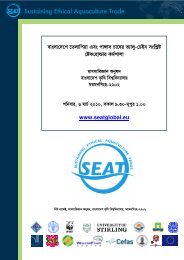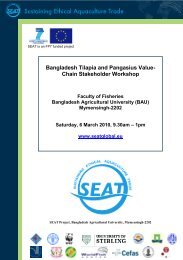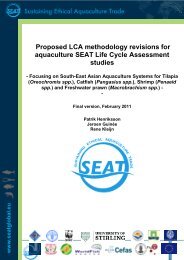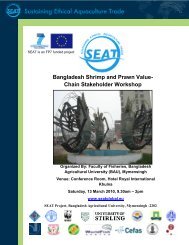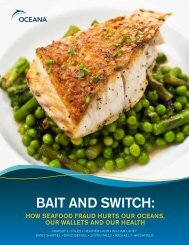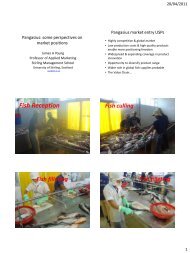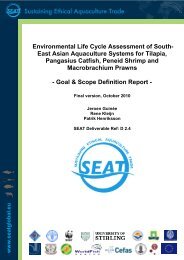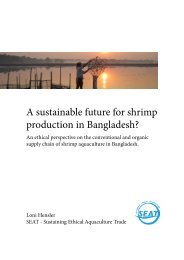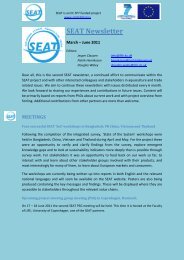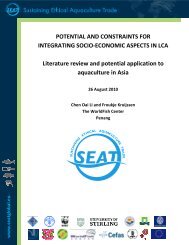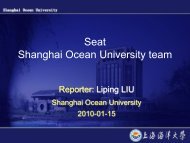D4.1 Review of Environmental Models - SEAT Global
D4.1 Review of Environmental Models - SEAT Global
D4.1 Review of Environmental Models - SEAT Global
Create successful ePaper yourself
Turn your PDF publications into a flip-book with our unique Google optimized e-Paper software.
programmed in Borland Delphi 7 (SAMS, 2004). The model was used as part <strong>of</strong> the ECASA<br />
project as it user friendly and has been validated. It is also easily adaptable for different<br />
species and environments (SAMS, 2004).<br />
1.3.2 FARM (Farm Aquaculture Resources Management)<br />
The Farm Aquaculture Resources Management Model is based on shellfish cultivation, <strong>of</strong><br />
which there are relatively few models (Ferreira et al, 2007). It has been condensed from<br />
more complex models and utilises parameters for which data is readily available. The<br />
program was developed in order to allow an aquaculturist to determine the maximum<br />
shellfish density that would provide a sustainable carrying capacity to the surrounding area<br />
(Ferreira et al., 2007). It takes into account a variety <strong>of</strong> factors including farm size, food<br />
supply and any environmental parameters to calculate the yield <strong>of</strong> the farm (FARM, 2010).<br />
The model involves the integration <strong>of</strong> a number <strong>of</strong> models including; growth models for both<br />
finfish and shellfish, production models, economic models and nutrient and eutrophication<br />
models (Ferreira et al, 2009). It has been applied in various locations in the EU from Scotland<br />
to Italy (Ferriera et al., 2009). FARM is not only an environmental monitoring tool but also a<br />
tool, which can take into account the economics <strong>of</strong> the mariculture practice in question in<br />
turn assisting in developing in better management for the farm concerned. (Ferreira et al,<br />
2007) FARM is currently undergoing more developments to allow it to model for other forms<br />
<strong>of</strong> culture such as seaweeds and fish cages (Ferreira et al, 2007).<br />
1.3.3 APEM (Aquaculture Pond Ecosystem Management)<br />
Many models have been developed for pond aquaculture, as this is a method responsible for<br />
culture <strong>of</strong> many species (Boyd & Tucker, 1998). These models are <strong>of</strong>ten site specific and data<br />
intensive rendering them too specific to be used on other systems (Losordo & Piedrahita,<br />
1991). The Aquaculture Pond Ecosystem Model was developed in order to provide a simpler<br />
more general, user friendly, method for modelling these systems, enabling application to a<br />
number <strong>of</strong> ponds types (Culberson and Piedrahita, 1996). The model looks at the biological,<br />
physical and chemical aspects <strong>of</strong> the pond but simplifies the processing. In doing this<br />
Culberson and Piedrahita (1996) have produced a model which covers a larger range <strong>of</strong><br />
ponds and allows for ponds with limited data sets to be simulated. The model produced<br />
accounts for Temperature and thermal energy dynamics, simulating the vertical heat<br />
transfer within the pond as well as the Dissolved Oxygen dynamics, simulating plankton<br />
photorespiration and sediment and water column respiration. The model was developed in<br />
the STELLA framework and consisted <strong>of</strong> stocks and flows to simulate an outcome.<br />
To determine the range <strong>of</strong> use <strong>of</strong> the model, simulations were carried out for three areas,<br />
using data from the Pond Dynamics/Aquaculture Collaborative Research Support Program<br />
database including; Honduras, Rwanda and Thailand (Culberson and Piedrahita, 1996). The<br />
ponds covered a range <strong>of</strong> areas; coastal, inland and elevated from sea to mountains in<br />
Africa.<br />
The model was found to simulate erroneous results for the temperature model in Honduras,<br />
resulting in underestimations, however consistently the errors showed only a 1 o C difference<br />
for the entire model run. A similar issue arose when the model was used for pond culture in<br />
Rwanda; this time the difference was consistently 1.5 o C different.<br />
Page 15



